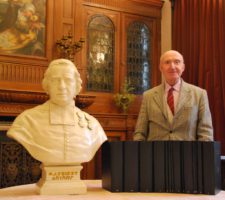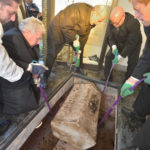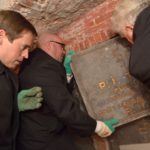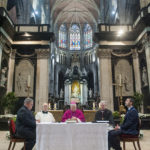In 2001, the three Triest congregations petitioned to open the process of beatification of their founder. This was formalized by the opening of the process in Saint Bavo’s Cathedral in Ghent on 26 August 2001 with Mgr. Arthur Luysterman, Bishop of Ghent, presiding. In addition, Brother René Stockman, Superior General of the Brothers of Charity, was appointed promoter of the Cause and Brother Eugeen Geysen was named postulator.
This historical process demanded a lot of research in the archives of the congregations and beyond. Following the death of Bro. Eugeen Geysen, a new postulator was installed on 19 November 2012, Dr. Waldery Hilgeman. At the same time, Rev. Fr. Dirk Van Kerchove was appointed episcopal delegate and Mr. Lieven Claeys was nominated as notary. Rev. Fr. Jürgen François was appointed promoter of justice. A historical commission, headed by Bro. René Stockman, tried to bring Bro. Eugeen Geysen’s work to a successful conclusion.
This historical process demanded a lot of research in the archives of the congregations and beyond. Following the death of Bro. Eugeen Geysen, a new postulator was installed on 19 November 2012, Dr. Waldery Hilgeman. At the same time, Rev. Fr. Dirk Van Kerchove was appointed episcopal delegate and Mr. Lieven Claeys was nominated as notary. Rev. Fr. Jürgen François was appointed promoter of justice. A historical commission, headed by Bro. René Stockman, tried to bring Bro. Eugeen Geysen’s work to a successful conclusion.
- Opening of the tomb
- Tombhouse P.J. Triest in Lovendegem (BE)
In 2015, the diocesan phase of the process was completed and the process was officially concluded on 15 November. It was the bishop of Ghent, Mgr. Luc Van Looy, who declared the process formally closed, sending no fewer than 22,000 pages of documents to Rome. These documents include all of Canon Triest’s writings and their translation into English, an official biography, the interrogatories of more than 50 witnesses who stated what Father Triest means to them, and anything that was ever published about Canon Triest.
- Closure diocesan process
On 18 November 2015, these documents were handed over to the Congregation for the Causes of Saints at the Vatican, which initiated the Roman phase of the process.
After a technical inspection of the documents, a commission will be formed that will examine the Cause with regard to content. Meanwhile, the positio needs to be composed, which includes the biography, the report of the historical commission, the report of the interrogatories, and the positio as such. This is a text containing arguments why it is believed that the Servant of God lived the Christian virtues in a heroic way and could therefore be beatified and canonized.
Based on the examination and the positio, the commission will submit its final report to the Congregation, after which a committee of cardinals will assess this final report. If the assessment is positive, the prefect of the Congregation for the Causes of Saints will make a recommendation to the Pope. If this recommendation is accepted and receives a positive reply, the Servant of God is declared Venerable. After that, we will be waiting for a miracle so that the Pope can announce the beatification.
As part of the beatification, the candidate can be venerated in the local Church, in our case within the congregations he founded and in Belgium where he lived.
As part of the canonization, which can be announced following the acknowledgement of a second miracle, he is declared a Saint and can venerated in the universal Church.










